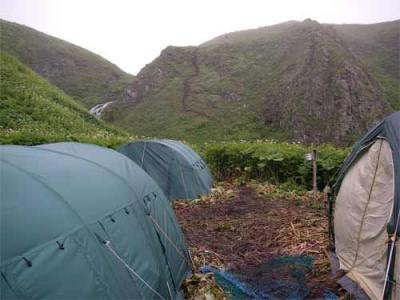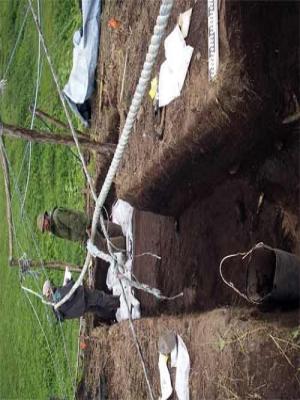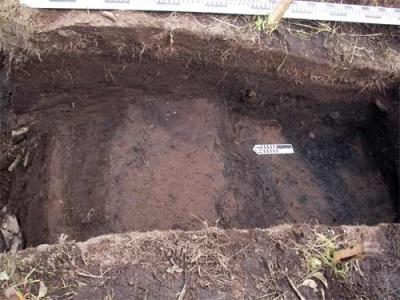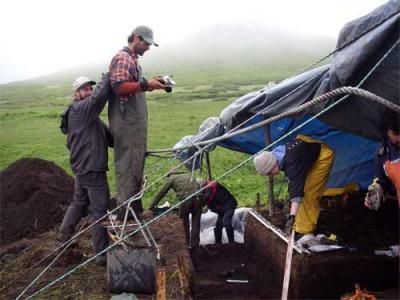These two days were our longest, hardest days of work as we tried to finish up the excavation work before our scheduled departure from Simushir on July 31.
 A view of our commute to work at the Vodapadnaya Field Camp. Colby Phillips is climbing the path up the 42 m high terrace that leads to the excavation site. On the left you can see the waterfall that gives the site its name – Vodapadnaya means “Place with waterfall” in Russian.
A view of our commute to work at the Vodapadnaya Field Camp. Colby Phillips is climbing the path up the 42 m high terrace that leads to the excavation site. On the left you can see the waterfall that gives the site its name – Vodapadnaya means “Place with waterfall” in Russian.
A view of our commute to work at the Vodapadnaya Field Camp. Colby Phillips is climbing the path up the 42 m high terrace that leads to the excavation site. On the left you can see the waterfall that gives the site its name – Vodapadnaya means "Place with waterfall” in Russian.
The excavation site had changed quite a bit since we started nearly one week before. We began with only three excavation units – a 1 m x 2m and two-2 m x 2m. These were lined up with the eastern side of the test pit that had been dug last year and arranged so that they were between two pit houses and would cause the least amount of disturbance to the houses themselves.
The hope was that we would encounter more of the midden that we had excavated last year, which was primarily urchin remains. The urchin remains change the chemistry of the soil and make it so that more of the bones and other artifacts, such as bone or wood tools, are preserved. So often at excavation sites, the "soft” artifacts, like bones, wood or shells, are easily decomposed and all that remains is the "hard” artifacts, like stones and burned bones or wood/charcoal.
Last year we had dug a 1 x 1 m test pit that went down to about 70 cm and were able to recover enough bones and artifacts that we knew that wanted to return to the site to obtain a larger sample and to do a more thorough excavation.
Unfortunately, we discovered that the sea urchin midden is not very extensive or as large as we had hoped. We were only finding a small amount of urchin in Unit 1 and even though we were finding lots of charcoal, fire cracked rock and stone tool artifacts, we weren’t finding urchin midden in Units 2 or 3.
So Ben and Mike decided that we needed to change our strategy a little bit and another 1m x 2m exploratory test pit unit was opened south of the original test pit from last year. This unit was perpendicular to the rest of the excavation and headed into the area that was probably a pit house.
 Matt Walsh and James Taylor working in the nearly finished Vodapadnaya excavation site. In the foreground you can see Unit 1 (narrow with the bucket in it) and the edge of Unit 4 which goes to the right at the bottom of the picture. Matt and James are standing in Unit3 and Unit 2 is between them and Unit 1.
Matt Walsh and James Taylor working in the nearly finished Vodapadnaya excavation site. In the foreground you can see Unit 1 (narrow with the bucket in it) and the edge of Unit 4 which goes to the right at the bottom of the picture. Matt and James are standing in Unit3 and Unit 2 is between them and Unit 1.
*Matt Walsh and James Taylor working in the nearly finished Vodapadnaya excavation site. In the foreground you can see Unit 1 (narrow with the bucket in it) and the edge of Unit 4 which goes to the right at the bottom of the picture. Matt and James are standing in Unit3 and Unit 2 is between them and Unit 1. *
More urchin midden was discovered in what was now Unit 4 – immediately adjacent to last year’s test pit was another 20 cm or so of urchin midden, which Mike excavated. In addition to the bones of many birds, some foxes or dogs and marine mammals, there were several "very cool” artifacts – such as a bone bilateral harpoon point with 5 barbs and a harbor seal effigy carved from bone.
After the midden was excavated, the southern half of Unit 4 was excavated down through the pit house floor. There we found the burned remains of the pit house rafters and other evidence that this house might have burned down at some point in the past.
 The wall of the pit house is just left of the North-Scale arrow. To the left in the image is the location of the sea urchin midden and to the right is the pit house floor.
The wall of the pit house is just left of the North-Scale arrow. To the left in the image is the location of the sea urchin midden and to the right is the pit house floor.
*The wall of the pit house is just left of the North-Scale arrow. To the left in the image is the location of the sea urchin midden and to the right is the pit house floor. *
While that part of the excavation was completed, the rest of us worked to excavate Units 2 and 3 down to "sterile” – which means we excavate down until we get to a level where there is no more charcoal or artifacts, as determined by using the soil probe, for at least another 10-20 cm below. Units 2 and 3 were less complicated in their stratigraphy than Units 1 and 4. It appears that the Okhotsk people that lived here partially dug up and disturbed the area in and around the midden. For that reason, Units 2 and 3 were finished up on early on July 30, while Unit 1, which was started on the same day, was finished up late on July 30. Unit 4, which was begun last, was not finished until early morning on July 31.
Once each Unit is finished with its excavation, however, there is still a lot of work to be done!
 Ben Fitzhugh (with the assistance of Matt Walsh) photographs the floor of Unit 1. Dani Plante is holding the scale rods to indicate its size and depth. At the right edge of the picture, Nick Shankle is working in Unit 4. At the back of the image, James Taylor and Dima Shubin are working to finish Unit 3, which is covered with plastic to protect the floor.
Ben Fitzhugh (with the assistance of Matt Walsh) photographs the floor of Unit 1. Dani Plante is holding the scale rods to indicate its size and depth. At the right edge of the picture, Nick Shankle is working in Unit 4. At the back of the image, James Taylor and Dima Shubin are working to finish Unit 3, which is covered with plastic to protect the floor.
Ben Fitzhugh (with the assistance of Matt Walsh) photographs the floor of Unit 1. Dani Plante is holding the scale rods to indicate its size and depth. At the right edge of the picture, Nick Shankle is working in Unit 4. At the back of the image, James Taylor and Dima Shubin are working to finish Unit 3, which is covered with plastic to protect the floor.
There will be more about all of the work that we do to completely document the site in my next journal.
Da Svidanya!
Misty

